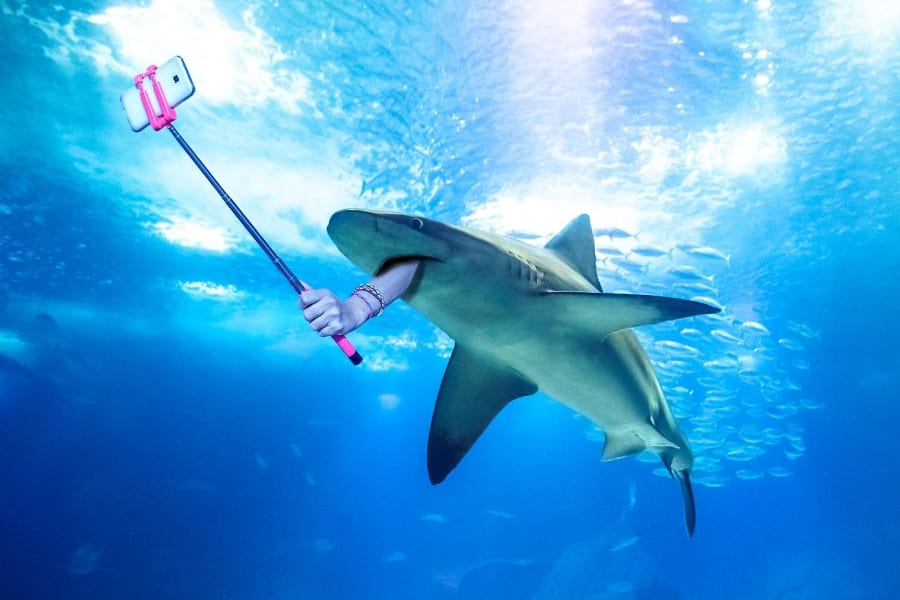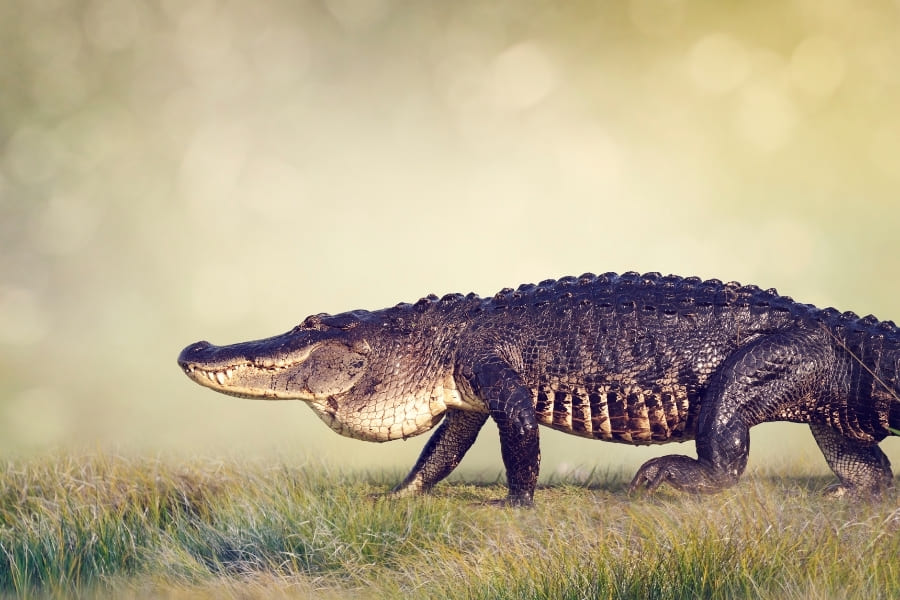Blockbusters like „Jaws“, „Deep Blue Sea“ and „Open Water“ show: There is hardly an animal we admire and fear more than sharks. For some people, they are the epitome of terror. Others, however, are intrigued by the hunting skills these predators honed during Millions of years of evolution.
Whether you like them or fear them: Scientists now believe that their image as bloodthirsty killers is far from the truth. At the same time, the role that sharks play for the eco-system ocean becomes more and more clear.
If you are interested in sharks, Florida is THE place to be. Here, multiple species populate the coastal waters where they can be observed during dives. If you want to keep your distance, you can also learn more about sharks at Florida’s zoos and aquariums. And of course, there are also the remains of these predators in the form of shark teeth.
In this article, we will shed light on sharks in general, and specifically on sharks in Florida: Which species are found near the coast, where can they be observed and what are the best trips you can take to see sharks up-close and personal?
In addition, you will learn more about shark attacks in Florida and how to avoid unwanted trouble with these animals.
Shark Facts
Sharks are among the most fascinating animals in our oceans – especially, because we are far from knowing everything about them. What we do know, however, paints the picture of a highly complex and diverse group of sea creatures.
Origin and Evolution
Sharks have been living in our oceans for a whopping 400 Million years – long before the first dinosaurs were around. This can still be seen in fossilized shark teeth. By far the most fearsome species was Megalodon: a giant shark that went extinct 2 Million years go. This monster is estimated to have reached up to 65 feet – four times the size of a great white shark.
Species and Distribution
Worldwide, there are about 500 species of sharks, with vast differences in sizes and shapes. They populate every body of saltwater: from coastal shallows and the open ocean to the deep sea. Some species like river and bull shark are even found in fresh water.
Characteristics
Sharks are perfectly adapted to their lives as oceanic predators – as can be seen by the following characteristics:
- Luckily for them, sharks do not need a dentist. The animals are able to regrow up to 30.000 teeth in the course of their lives. This is made possible by so-called revolver dentition with multiple rows.
- Sharks possess rippled skin that allows them to glide through the water without major friction. This design is so energy-efficient that scientists are trying to copy it for ships and airplanes.
- Shark eyes are able to detect ten times more light than human eyes. In addition, the animals have an excellent sense of smell, with which they can find pray from miles away.
- This is not all, however: Sharks are also equipped with a lateral line organ that detects even the slightest ripples in the water. What is more, they can use the earth’s magnetic field in order to navigate.
Social Behavior
Many people still think of sharks as cold-blooded killers. In reality, though, many shark species are highly social, with individuals regularly pairing up and hunting together – true shark friendships, if you will. Scientists now believe that these animals have a social structure as complex as that of dolphins. There is a difference, however. Because sharks are unable to produce sounds, they mainly communicate with a number of swimming motions.
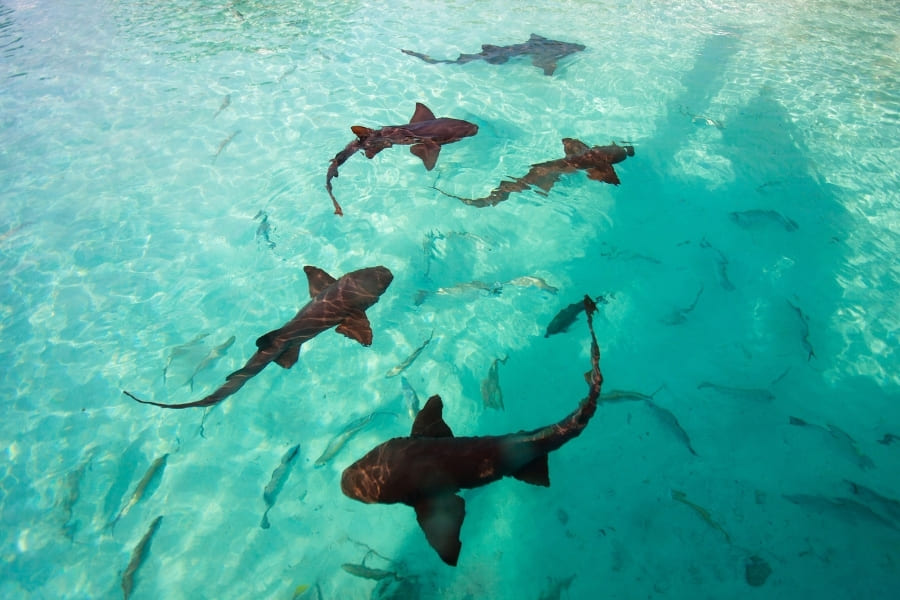
Reproduction
So far, not much has been known about the reproductive behavior of sharks. We do know, however, that the eggs of all sharks are fertilized inside the female’s body. During mating, scientists could observe male sharks using their teeth to hold on to the female’s pectoral fin and avoid getting drifted away.
Baby Sharks
While some shark species lay eggs, others bear live offspring. An example for the latter is the great white shark. Their young are able to survive on their own right after birth. However, little shark prefer to spend their first years in coral reefs that offer protection from bigger predators.

Endangerment and Protection
Right now, 70 shark species are threatened with extinction – especially in the Mediterranean Sea. The animals get trapped in fishing nets or are hunted for their meat. A particularly brutal practice is called “Finning”: cutting of a shark’s fins and throwing the animal back into the ocean. In addition, sharks are also threatened by water pollution.
Organizations like the WWF and Greenpeace have made the protection of sharks their task. Important issues include stricter fishing quotas and a ban of finning, as well as legislation that prohibits the sale of shark meat.
Sharks by Florida
The Sunshine State’s coastal waters are a perfect refuge for many aquatic creatures. Thus, it should come as no surprise that sharks are a common sight in Florida.
Shark Species in Florida
Florida’s waters are home to more than 30 species of shark that come in all shapes and sizes – from small angel sharks that resemble flounders to reef sharks, tiger sharks, hammerheads and gigantic whale sharks. The iconic great white shark, known from movies and TV shows, is also found in Florida.
Here are some facts about Florida’s different shark species:
- The most common species are lemon sharks with their characteristic green-yellowish skin. These sharks can be observed off the coast the whole year round.
- 6,5–10 feet long silk sharks are another common sight. Unlike more solitary species, these sharks assemble in groups that can contain up to 1,000 individuals.
- Whale sharks are the biggest fish found in Florida’s waters. Despite their giant size, they do not pose a threat to humans as they only feed on small crustaceans.
- Mako sharks are record-holders when it comes to speed. This species is mostly spotted in the open sea and can reach up to 40 mph when swimming.
- Great white sharks used to be a rare sight in Florida. In the last years, however, scientists have been able to observe an increase in their population.
Shark Attacks in Florida
Even though the chance of getting bitten by these predators is extremely small, shark attacks can and do occur in Florida.
Oftentimes, the culprits are black-tipped reef sharks. These specimen measure 5,2–6,6 feet in length and are known to venture into shallow waters where they come in contact with swimmers. Luckily, attacks are rarely ever fatal.
A bigger threat are 7,2–13 feet long bull sharks. These predators are regarded as unpredictable and aggressive towards divers. Not surprisingly, bull sharks are responsible for the majority of all shark attacks world-wide.
This is not to say that you have to watch out for sharks at every stretch of coast in Florida. By now, many beaches have been equipped with early warning systems and shark nets, which have reduced the attacks.
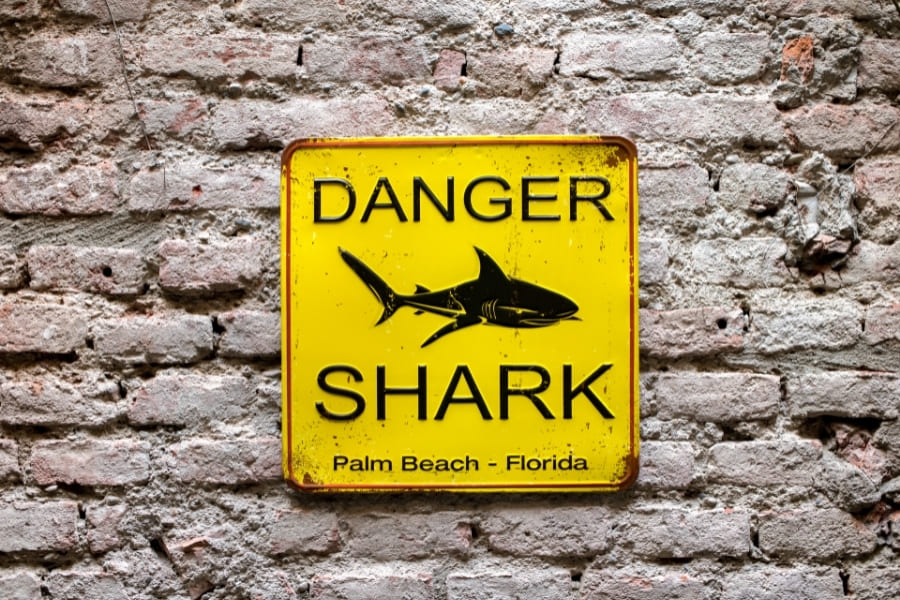
This is evident by the official numbers for the state of Florida:
Shark attacks 2020: 16
Shark attacks 2019: 21
Shark attacks 2018: 16
In addition, shark attacks are not evenly distributed across the state. This map shows that most incidents occur in the counties Volusia, Brevard and Palm Beach on Florida’s east coast – followed by Jacksonville, Miami, Miami Beach and the Florida Keys.
Florida’s west coast at the Gulf of Mexico and the Cape Coral/Fort Myers area in particular are much less affected.
Tips to avoid Shark Attacks
If you are swimming at an unguarded beach in Florida, you should heed the following safety rules:
- Sharks can smell blood from a large distance. Therefore, you should never step into the water with an open wound.
- For the same reason, do not swim at spots where diving seabirds suggest the presence of bait.
- Reflecting jewelry is known to attract sharks, so you best take it off before swimming.
- Groups offer a certain level of safety as sharks are more prone to attacking single individuals.
- Many shark species are nocturnal. Therefore, you should avoid swimming at night.
- In case of a shark attack, fight back. Hitting the animals’ eyes, snouts and gills is a good way to scare away sharks.
- If you are bitten by a shark, you have to seek medical treatment immediately. Even small wounds can lead to life-threatening infections if left untreated.
The best Places to observe Sharks in Florida
If you want to obverse Sharks in the wild, Florida is the perfect place for you. These predators populate the entire coast of the state and can be seen on boat or diving trips.
Which sharks you will see depends largely on the time of year:
Species like lemon sharks, nurse sharks and bull sharks can be found the whole year round. The same is true for whale sharks, although you will need a considerable amount of luck to spot these giants.
In the summer, Caribbean reef sharks, sandbank sharks, black sharks and hammerheads populate the coast, and if you want to observe tiger sharks, the months of December to July are perfect.
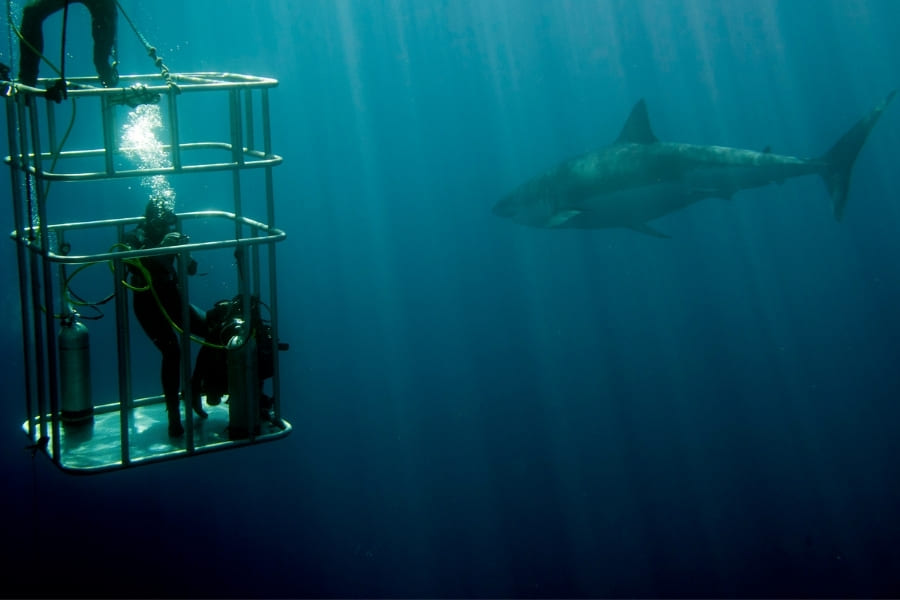
Sharks in the Florida Keys
The Florida Keys harbor more sharks than any other place in the world, making this island chain an ideal spot for shark watching.
Companies like Keys Shark Diving allow you to observe sharks from the comfort of a boat while also offering shark encounters in open water. A diving license is not needed, as you will be put into a special cage.
Another worth-while spot is Dry Tortugas National Park situated 70 miles away from Key West. Here, scientists were able to observe the mating of nurse sharks. The only way to reach this remote park is by boat. You also need a license that you can obtain on Garden Key.
Sharks in Palm Beach
Off the coast of Palm Beach, multiple shark species can be found – among them, tiger sharks, hammerheads and bull sharks that populate the coral reefs.
If you do not own a boat, we recommend the company Shark Tours Florida in Riviera Beach. On the three hour long “Swimming with Sharks” tour, the team will take you to the best places to observe more than 10 shark species. Excellent visibility levels add to the enjoyment. If you do not want to step into the water despite all the safety measures, you can also observe the predators from the boat.
Another provider is Florida Shark Diving in Jupiter. This company lets you choose between free dives and cage diving. Thanks to the sharks being baited with food, sightings are guaranteed.
Sharks in Miami
Florida’s most trending city is another hot-spot to go shark watching. For example, how about a trip with Miami Shark Tours? This company offers boat tours where you can see the animals from a safe distance – perfect for families. Alternatively, guests are able to do free and cage diving. Thanks to 10 years of experience, the tour guides know exactly where sharks can be spotted in great numbers.
Sharks in the Everglades
The coastal waters of Everglades National Park are home to a great number of bull sharks. These 7–10 feet long predators often swim up-river where they can be seen on a boat trip. Diving with bull sharks, however, is not advisable as they are known to be volatile and aggressive.
Near the coast, you can also spot other species that partially live in saltwater: black-tipped reef sharks and lemon sharks.
Sharks at Florida’s Zoos and Aquariums
You do not have the time for a boat trip but want to see sharks up-close? Then, we can recommend the following zoos and aquariums in Florida:
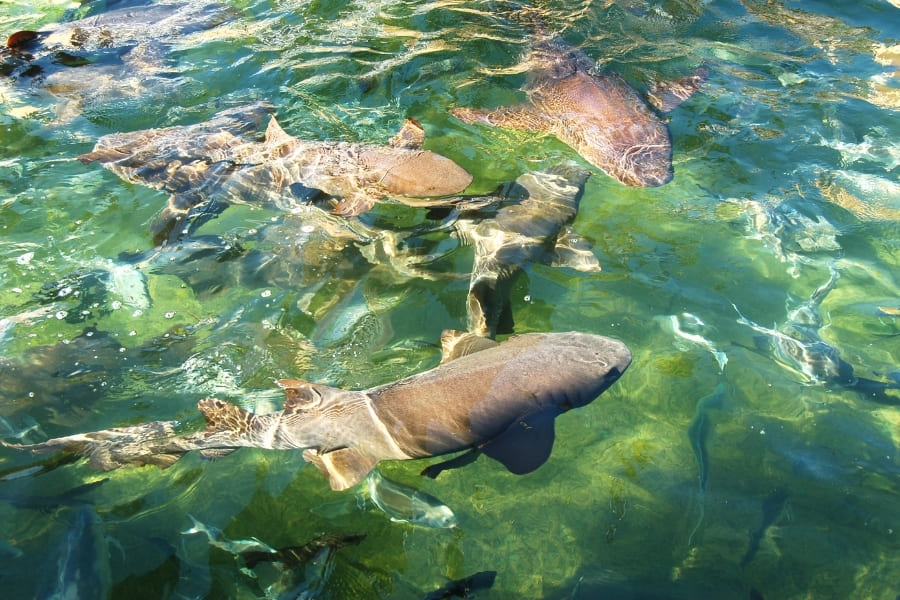
Florida Aquarium
At Tampa’s Florida Aquarium, you can swim with sharks, even if you do not own a diving license. The activity “Swim with the Fishes” makes it possible. Equipped with snorkel and mask, you will step into the pool and get up close with these predators. Sharks, however, are not the only animals there. The pool is also teeming with barracudas, stingrays and turtles.
SeaWorld
This aquarium in Orlando is home to the biggest artificial shark pool in the world. Shark Bay has been designed as a tropical reef with two levels, so you can observe the sharks above and below water. Alternatively, grab a snorkel and get within touching distance to (harmless) reef sharks. Or step into a glass cage to feed sharks, stingrays and turtles.
Miami Seaquarium
At the Miami Seaquarium, you can give handshakes, or rather “fin-shakes”, to cute nurse sharks and sting rays. The “Shark and Stingray Interaction” in a shallow pool makes it possible. Additionally, you can watch the 200 pound giants in the Shark Cannel getting fed by divers.
Theater of the Sea
The aquarium Theater of the Sea in Islamorada also offers animal encounters in shallow water. Here, you can go toe to toe with harmless nurse sharks to pet and even feed them. In addition, you have the opportunity to snorkel with sharks in a deeper saltwater lagoon.
Disney World
The “happiest place on earth” features sharks at the aquarium The Seas with Nemo & Friends at Epcot. Here, tiger sharks, blacknose sharks and other species live in a pool filled with 5.7 million gallons of water. At the 30 minute snorkeling trip, you can get even closer to these predators – and to the turtles that are also swimming in the pool.
Tarpon Springs Aquarium
A true hidden gem for shark fans is located north-west of Tampa: The Tarpon Springs Aquarium features lemon sharks, nurse sharks and cat sharks. Children are allowed to feed these little specimens, and in addition, you can watch the bigger sharks being fed by divers.
Collecting Shark Teeth in Florida
Even if you do not see a real shark – these fish leave their marks in the form of teeth that get washed up on the state’s beaches. With a bit of luck, you can even find the dentals of long- extinct species.
Finding grounds are scattered across the entire coast of Florida. If you want to increase your chances, though, you should visit the following places:
The city of Venice is widely regarded the Shark Tooth Capital of the World. Here, no barrier islands block the coast, so thousands of prehistoric teeth can be collected.
Other worth-while spots on Florida’s west coast include Captiva and Sanibel Island. And do you remember the extinct shark species Megalodon? It is particularly after storms that the 4–8 inch teeth of this giant are washed up on the shores of Manasota Key.
Jacksonville on the northern east coast is another hot-spot, as the migration routes of sharks run alongside the shore. The same is true for beaches in St Augustine, Jupiter and Palm Beach.
Sharks by Florida FAQ – frequently asked Questions
How old do Sharks get?
This depends largely on the species. Small cat sharks, for example, mostly live up to 8 years, while great white sharks can reach 70 years. The record, however, is held by the Atlantic Greenland shark. Some of these fish have been alive for more than 200 years, making them the oldest vertebrates in the world.
What do sharks eat?
Depending on their age and size, sharks feed on fish, mollusks, crabs, but also dolphins, turtles, seals, penguins, and other sharks. The giant whale shark exclusively feeds on plankton, while great white sharks are also known to scavenge. Humans, however, are not on a shark’s menu. If the animals do attack, it is mostly because they feel threatened or mistake humans for prey.
Do sharks lay eggs?
Roughly half of all shark species lay eggs that the males fertilize inside the female’s body. The eggs are protected by a special layer and contain yolk for the shark embryos to feed on. Long strings allow the eggs to anchor themselves on algae and avoid getting drifted away.
Are sharks mammals?
Some shark species give birth to live young. Despite this, they are not mammals, but fish – cartilaginous fish, to be precise. Scientists believe that the last common ancestor of humans and sharks lived about 440 Million years ago.
Do sharks sleep?
Even apex predators of the ocean have to rest from time to time. However, scientists still do not know if they sleep like humans do. In any case, most sharks have to stay on the move constantly. Otherwise, they would drown as they rely on the constant stream of water into their gills. Some species like reef and nurse sharks, though, are able to remain motionless on the seabed.
Are sharks dangerous?
Of the 500 shark species world-wide, only 7 are considered dangerous for humans: among them, great white sharks, tiger sharks, blue sharks, black-tipped reef sharks and bull sharks. The latter two are responsible for most attacks in Florida. The number of incidents, however, is vanishingly low: In the years 2018–2020, only 16–21 attacks occurred every year.
How many sharks are there in the world?
The exact number of all sharks can only be estimated. If one counts all 500 species, the number could well be 1 billion or more. Many of these predators are endangered, though. Every year, more than 100 million sharks are killed, and scientists believe that the global shark population has dropped by 70 % in the last 50 years.


